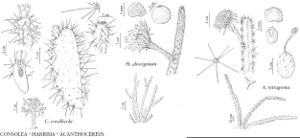Acanthocereus
Contr. U.S. Natl. Herb. 12: 432. 1909.
| Taxon | Illustrator ⠉ | |
|---|---|---|
 | Consolea corallicola Harrisia aboriginum Acanthocereus tetragonus | John Myers John Myers John Myers |
Shrubs, erect to arching, clambering, or climbing, often sparingly branched, sometimes forming impenetrable thickets. Roots diffuse, adventitious where arching stems touch soil. Stems segmented or unsegmented, green, greatly elongate, angled, 30–400 [–700] × (4–) 6–10 cm; ribs 3–5 [–7], narrowly triangular to winglike, very prominent, 3–5 cm deep, less than 1 cm thick, rib crests undulate; areoles widely spaced, located next to sinuses, 2–5 cm apart along ribs, circular to oval, short woolly. Spines [0–] 4–10 per areole, diffusely spreading, brown or reddish [white, yellowish, or black], aging gray, ± straight, acicular to subulate, terete or somewhat flattened, longest spines 10–40 [–70] mm, hard; radial spines [0–] 6–8 per areole, 5–25 mm; central spines [0–] 1–2 [–4] per areole, 0–40 mm. Flowers nocturnal, lateral to terminal on stems 1 or more years old, at adaxial edge of areoles, funnelform, [11–] 14–20 [–25] cm; outer tepals green or purple-tinged, lanceolate-linear, 3–5 × 1 cm; inner tepals white, broadly linear to narrowly oblanceolate, 5–15 × 1–4 cm, margins entire or minutely denticulate; ovary minutely scaly, spiny [spineless], with short wool; stigma lobes 10–15, white, to 12 mm. Fruits indehiscent or irregularly dehiscent longitudinally, red to red-purple, spheric, ovoid, ellipsoid, oblong, or pyriform, 30–80 [–120] mm, fleshy or juicy [tough in A. columbianus], scaly, spiny [or spineless]; scales deciduous; pulp red; floral remnant persistent. Seeds black, broadly obovoid, to 4.8 mm, smooth and shiny; testa cells flat. x = 11.
Distribution
se United States, Mexico, West Indies, Central America, n and e South America
Discussion
Species 6 (1 in the flora).
Acanthocereus needs critical taxonomic study. E. F. Anderson (2001) followed W. Barthlott and D. R. Hunt (1993) in recognizing six species; other accounts have recognized up to twelve species or as few as two (A. tetragonus and A. occidentalis Britton & Rose).